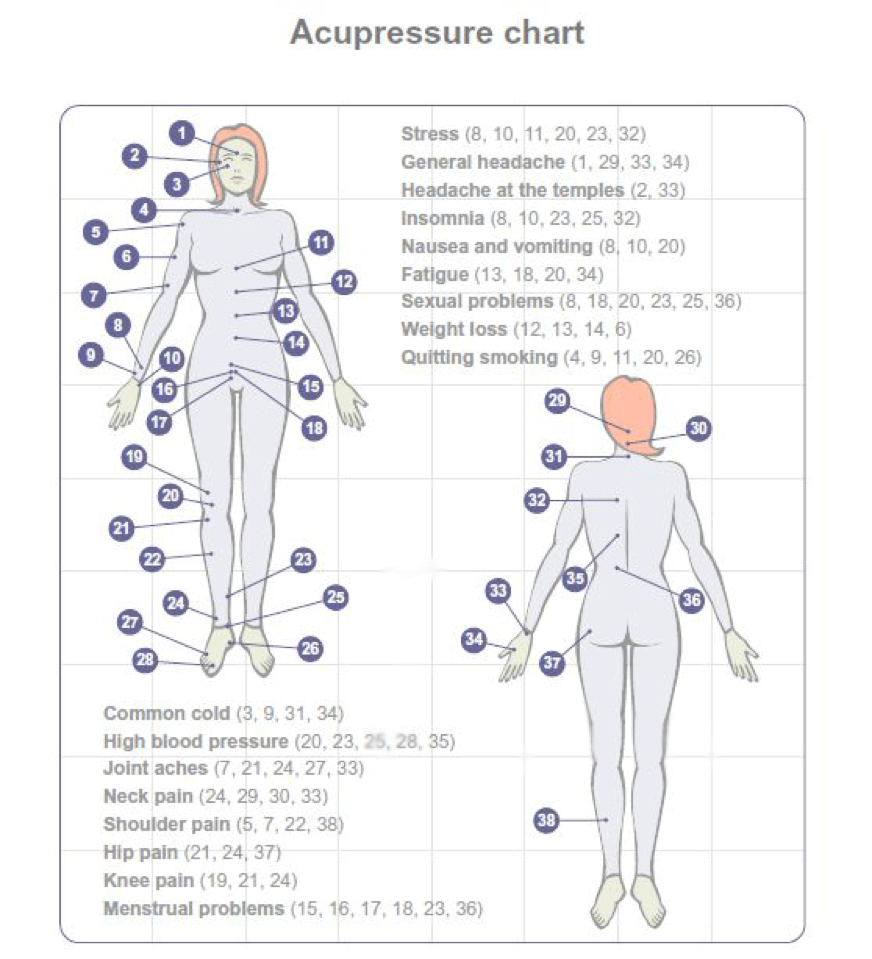About Acupressure

Definition
Acupressure is a form of touch therapy that utilizes the principles of acupuncture and Chinese medicine. In acupressure, the same points on the body are used as in acupuncture, but are stimulated with finger pressure instead of with the insertion of needles. Acupressure is used to relieve a variety of symptoms and pain.
Purpose
Acupressure massage performed by a therapist can be very effective both as prevention and as a treatment for many health conditions, including headaches, general aches and pains, colds and flu, arthritis, allergies, asthma, nervous tension, menstrual cramps, sinus problems, sprains, tennis elbow, and toothaches, among others. Unlike acupuncture which requires a visit to a professional, acupressure can be performed by a layperson. Acupressure techniques are fairly easy to learn, and have been used to provide quick, cost-free, and effective relief from many symptoms. Acupressure points can also be stimulated to increase energy and feelings of well-being, reduce stress, stimulate the immune system, and alleviate sexual dysfunction.
Description
Origins One of the oldest text of Chinese medicine is the Huang Di, The Yellow Emperor’s Classic of Internal Medicine, which may be at least 2,000 years old. Chinese medicine has developed acupuncture, acupressure, herbal remedies, diet, exercise, lifestyle changes, and other remedies as part of its healing methods. Nearly all of the forms of Oriental medicine that are used in the West today, including acupuncture, acupressure, shiatsu, and Chinese herbal medicine, have their roots in Chinese medicine. One legend has it that acupuncture and acupressure evolved as early Chinese healers studied the puncture wounds of Chinese warriors, noting that certain points on the body created interesting results when stimulated. The oldest known text specifically on acupuncture points, the Systematic Classic of Acupuncture, dates back to 282 A.D. Acupressure is the non-invasive form of acupuncture, as Chinese physicians determined that stimulating points on the body with massage and pressure could be effective for treating certain problems.
Outside of Asian-American communities, Chinese medicine remained virtually unknown in the United States until the 1970s, when Richard Nixon became the first U.S. president to visit China. On Nixon’s trip, journalists were amazed to observe major operations being performed on patients without the use of anesthetics. Instead, wide-awake patients were being operated on, with only acupuncture needles inserted into them to control pain. At that time, a famous columnist for the New York Times, James Reston, had to undergo surgery and elected to use acupuncture for anesthesia. Later, he wrote some convincing stories on its effectiveness. Despite being neglected by mainstream medicine and the American Medical Association (AMA), acupuncture and Chinese medicine became a central to alternative medicine practitioners in the United States. Today, there are millions of patients who attest to its effectiveness, and nearly 9,000 practitioners in all 50 states.
Acupressure is practiced as a treatment by Chinese medicine practitioners and acupuncturists, as well as by massage therapists. Most massage schools in American include acupressure techniques as part of their bodywork programs. Shiatsu massage is very closely related to acupressure, working with the same points on the body and the same general principles, although it was developed over centuries in Japan rather than in China. Reflexology is a form of bodywork based on acupressure concepts. Jin Shin Do is a bodywork technique with an increasing number of practitioners in America that combines acupressure and shiatsu principles with qigong, Reichian theory, and meditation.